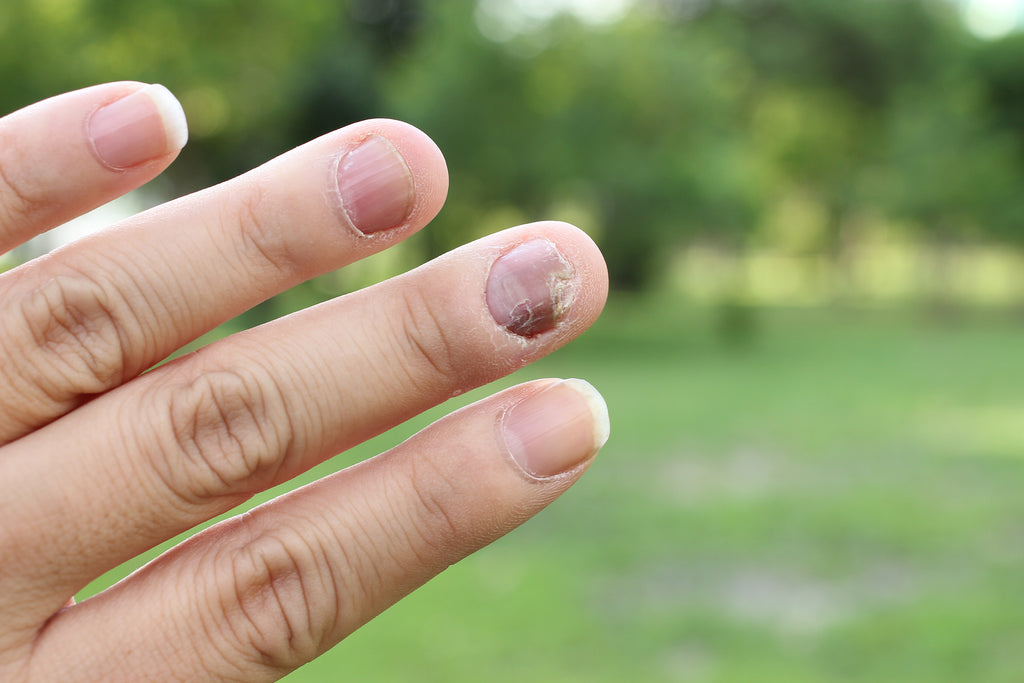What Causes Nail Psoriasis?
15 Apr 19

Psoriasis is a chronic immune-mediated disease that results in the development of patches of scaly, dry, red skin lesions. The most common kind of psoriasis affects the skin. However, nail involvement is also possible.
That leads us to then ask, what is nail psoriasis? Nail psoriasis is a form of psoriasis that, like given in the name, can be found on your fingernails and toenails. Nail psoriasis occurs in 55% of people that also have a variant of skin psoriasis, but in rare cases can occur on its own.
If you notice any of the following characteristics on your nails, then you may have nail psoriasis:
- A flaky, rough, or crumbly texture
- Detachment of nail from the nail bed
- Nails that hurt to touch
- Small indents or ridges covering your nail
- Spots of white, yellow, or brown discoloration
- Thick layers of nail
Although nail psoriasis only covers a small portion of the body, it can greatly affect a person’s daily life. Below, we will discuss the underlying causes of this condition and if there is a psoriasis treatment for the nails available.
What Causes Nail Psoriasis?
Nail psoriasis is an inflammatory immune-mediated disease, which means its symptoms are caused by a faulty functioning immune system. The immune system is meant to destroy cells that pose a threat to the body, but in individuals with nail psoriasis, the immune system overreacts and attacks healthy skin cells around the nail. Understanding how nails grow can help you envision why nail psoriasis presents in its typical manner.
The root of the nail is known as the matrix. This is where new cells are produced, pushing out old dead cells that make up the nail plate, or what is commonly referred to as nail. The reason cutting nails doesn’t hurt is because it’s made up of these dead cells that have no connection to nerves. In the cases of people with nail psoriasis, the matrix’s cell production revs up as it is attacked by the body’s own immune system. This results in overly thick nails with lots of dead cells sloughing off, creating a rough and crumbly texture.
What Worsens Nail Psoriasis?
People with skin psoriasis often track triggers that cause their symptoms, like psoriasis lesions, to worsen or flare up. Because their skin responds to changes within hours, avoiding certain things can cause the appearance of symptoms to diminish. That said, since nails take a long time to grow and cycle through, it can take a few months of psoriasis treatment or trigger avoidance to see improvements. Still, it’s important to understand what can cause nail psoriasis to worsen so that you can avoid aggravating the condition. Here are a few factors to watch out for:
- Activities that disturb the nail and cause loose nails to peel further
- Dry weather or harsh sun exposure
- Picking or scratching at cuticles
- Scraping out build up underneath the nail
- Stress
- Unhealthy habits like smoking, poor diet, and excessive alcohol consumption
- Wearing artificial nails
Other Factors Affecting Nail Psoriasis
Bacterial and fungal infections do not cause nail psoriasis. However, because nail psoriasis causes cracks in your body’s natural barrier, it becomes easier for bacteria and fungus to infect your nails. These infections can exacerbate your nail psoriasis since your nail will take damage from both the infection and your own immune system. There may also be a direct link with psoriatic arthritis and nail psoriasis. Researchers have demonstrated that fingernail psoriasis can be an early sign of psoriatic arthritis and have found that at least 80% of people with psoriatic arthritis also have fingernail psoriasis.
Can You Prevent Nail Psoriasis?
Whether a person experiences psoriasis of the nail is most commonly determined by genetic factors. This means that the disease is more likely to run in families, and there is no way to completely prevent onset. If you have a genetic predisposition that causes nail psoriasis to occur, then there is no cure, but you can manage the symptoms of nail psoriasis to alleviate any severe discomfort and improve the appearance of nails.
There are a few key ways you can prevent the worsening of nail psoriasis symptoms. Avoiding the flare-up triggers described above is a good place to start. You can also protect your fingernails and toenails by following these steps:
- Clean your nails—Use sterilized tools to gently trim nails, file them down, and buff them out. Soaking them in antibacterial soapy water will decrease the risk of infection.
- Moisturize your nails—This will not only improve their appearance but will prevent cracking.
- Shield your nails—wear gloves when working with your hands and wear shoes that do not rub against your toenails.
How Can You Treat Nail Psoriasis?
Treatments for nail psoriasis can be the same methods used to treat skin psoriasis. Creams that bring moisture back to the cell and prevent infections are effective while stronger medications such as steroids should not be used unless recommended by a doctor. Consult your doctor if you believe you have nail psoriasis and get treatment so that you can continue doing the activities you love.
Sources:

